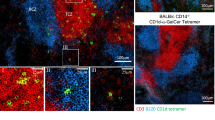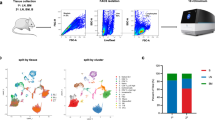Abstract
Distinct subsets of human peripheral T-cell populations have recently been characterized using mouse monoclonal antibodies and conventional hetero-antisera in functional tests in vitro1–6. ‘Inducer’ or ‘helper’ T cells have been shown to react with a monoclonal antibody termed OKT4. These OKT4+ cells respond to soluble antigens3, help B-lymphocyte differentiation into plasma cells in pokeweed mitogen stimulated cultures4 and assist the development of cytotoxic T cells in mixed lymphocyte cultures (MLC)3. In contrast, the ‘suppressor-cytotoxic’ T-cell subset is recognized by the monoclonal antibodies OKT55 and OKT86. The same subset can also be labelled with a conventional horse antiserum which (after extensive absorption) recognizes TH2 antigen5,7. These OKT8+, TH+2 cells fail to respond optimally to soluble antigen3 but contain the concanavalin-A induced suppressor cell population5,7 and the cells which develop cytotoxic activity in mixed lymphocyte reaction (MLR)-induced cell-mediated lympholysis3. The physiological role, tissue distribution and recirculation patterns of ‘inducer’ and ‘suppressor’ T cells are unknown, although changes in the proportion and activity of blood-borne T-ceU subsets have been observed in various immunoregulatory disorders8,9. We have therefore now analysed the distribution of these T-cell subsets in the lymphohaematopoietic organs and the gut. OKT4+, OKT8− cells of inducer type predominate in the thymic medulla, blood and T-cell traffic areas such as tonsillar paracortex and intestinal lamina propria. OKT4−, OKT8+; cells of suppressor-cytotoxic type, on the other hand, constitute the larger part of T-cell population in normal human bone marrow and gut epithelium. Furthermore, a close micro-anatomical relation can be seen between the OKT4+, OKT8−T cells and non-lymphoid cells expressing large amounts of la-like (p 28,33) antigens, for example, interdigitating (ID) cells and Ia+ macrophages, suggesting that Ia-like antigens may play a part in the local regulation of inducer T cell activity. Thus the T-cell subsets which have been shown to have different functions in vitro seem also to have different patterns of tissue distribution, implying different immunological functions in vivo.
This is a preview of subscription content, access via your institution
Access options
Subscribe to this journal
Receive 51 print issues and online access
$199.00 per year
only $3.90 per issue
Buy this article
- Purchase on Springer Link
- Instant access to full article PDF
Prices may be subject to local taxes which are calculated during checkout
Similar content being viewed by others
References
Kung, P. C., Goldstein, G., Reinherz, E. L. & Schlossman, S. F. Science 206, 347–349. (1979).
Reinherz, E. L., Strelkauskas, A. J., O'Brien, C. & Schlossman, S. F. J. Immun. 123, 83–86 (1979).
Reinherz, E. L., Kung, P. C., Goldstein, G. & Schlossman, S. F. Proc. natn. Acad. Sci. U.S.A. 76, 4061–4065 (1979).
Reinherz, E. L., Kung, P. C., Goldstein, G. & Schlossman, S. F. J. Immun. 123, 2894–2896 (1979).
Reinherz, E. L., Kung, P. C., Goldstein, G. & Schlossman, S. F. J. Immun. 124, 1301–1307 (1980).
Reinherz, E. L. et al. Proc. natn. Acad. Sci. U.S.A. 77, 1588–1592 (1980).
Reinherz, E. L. & Schlossman, S. F. J. Immun. 122, 1335–1341 (1979).
Reinherz, E. L. et al. New Engl. J. Med. 300, 1061–1068 (1979).
Reinherz, E. L. et al. New Engl. J. Med. 301, 1018–1022 (1979).
Tidman, N. et al. (in preparation).
Janossy, G. et al. J. Immun. 125, 202–212 (1980).
Janossy, G. et al. J. Immun. 123, 1525–1529 (1979).
Bradstock, K. F. et al. J. natn. Cancer Inst. 65, 33–42 (1980).
Cantor, H. & Boyce, E. Cotemp. Topics Immunobiol. 7, 47–62 (1977).
Simon, M. M. & Abenhardt, B. Eur. J. Immun. 10, 334–341 (1980).
Kaiserling, E., Stein, H. & Muller-Hermelink, H. K. Cell. Tissue Res. 155, 47–55 (1974).
Gaudecker, B. von & Muller-Hermelink, H. K. Adv. exp. med. Biol. 114, 19–22 (1979).
Heusermann, U., Stutte, H. J. & Muller-Hermelink, H. K. Cell Tissue Res. 153, 415–417 (1974).
Kaiserling, E. & Lennert, K. Virchows Arch. Cell Path. 16, 51–61 (1974).
Lampert, I. A., Pizzolo, G., Thomas, J. A. & Janossy, G. J. Path. 131, 145–156 (1980).
Selby, W., Janossy, G. & Jewell, D. Gut (in the press).
Veerman, A. J. P. Cell Tissue Res. 148, 247–251 (1974).
Hoefsmit, Ch. M. et al. in Structure and Morphology of the Reticuloendothelial System (ed. Curr, E.) 417–468 (Plenum, New York, 1980).
Olah, I., Röhlick, P. & Törö, I. Ultrastructure of Lymphoid Organs (Lippincott, Philadelphia, 1975).
LeFevre, M. E., Hammer, R. & Joel, D. D. J. reticuloend. Soc. 26, 553 (1979).
Katz, S. I., Tamaki, K. & Sachs, D. H. Nature, 282, 324–326 (1979).
Kelly, R. H., Balfour, B. M., Armstrong, J. A. & Griffiths, S. Anat. Rec. 190, 5–22 (1978).
Spry, C. J. F., Pflug, J., Janossy, G. & Humphrey, J. H. Clin. exp. Immun. 39, 750–754 1980.
Stingl, G. et al. J. invest. Derm. 71, 59–64 (1978).
Rowden, G., Lewis, M. G. & Sullivan, A. K. Nature 268, 247–248 (1977).
Silberberg Sinakin, I. et al. Cell. Immun. 25, 137–151 (1976).
Zinkernagel, R. M. et al. J. exp. Med. 147, 882–896 (1978).
Thorsby, E. et al. Transplantn Proc. 9, 393–399 (1977).
Rouse, R. V., van Ewijk, W., Jones, P. P. & Weissman, I. L. J. Immun. 122, 2508–2515 (1979).
Janossy, G. et al. Br. J. Cancer 42, 1–20 (1980).
Author information
Authors and Affiliations
Rights and permissions
About this article
Cite this article
Janossy, G., Tidman, N., Selby, W. et al. Human T lymphocytes of inducer and suppressor type occupy different microenvironments. Nature 288, 81–84 (1980). https://doi.org/10.1038/288081a0
Received:
Accepted:
Issue Date:
DOI: https://doi.org/10.1038/288081a0
Comments
By submitting a comment you agree to abide by our Terms and Community Guidelines. If you find something abusive or that does not comply with our terms or guidelines please flag it as inappropriate.



